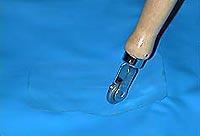
Warning for all Glue and Solvent Use: Use of these products can be very dangerous and can have short term and long term consequences to your health. It is important for you to take precautions and wear all appropriate safety gear. Wearing gloves, a respirator, eye protection, and working in a well ventilated area can go a long way towards mitigating these risks. To ensure a quality repair, read all instructions before beginning.
|
|||||||||||||||||||||||||||||||||||||||||||||||||||||||||||||





